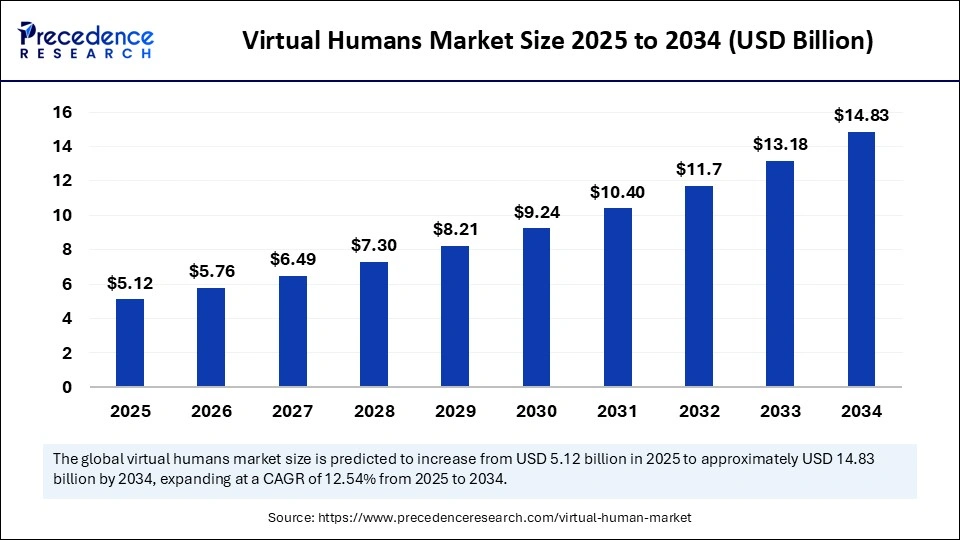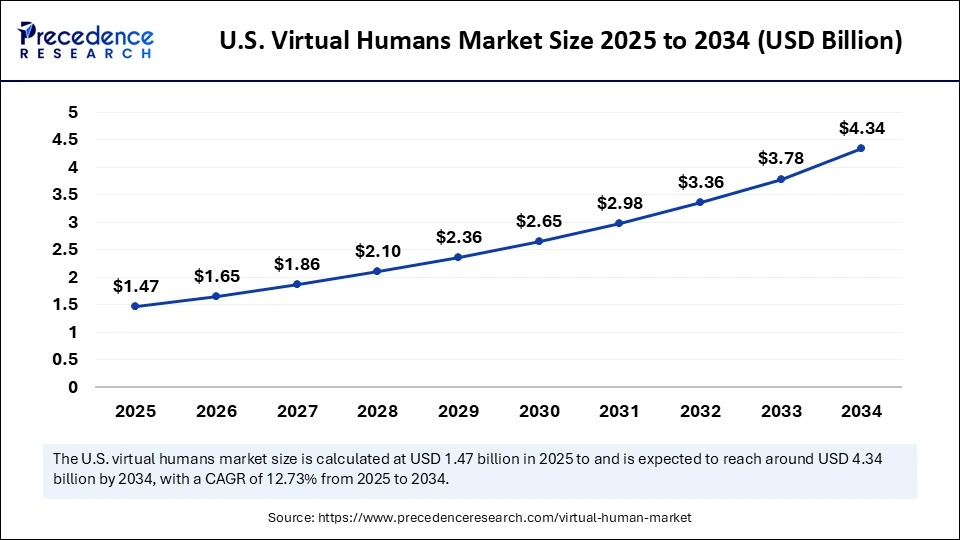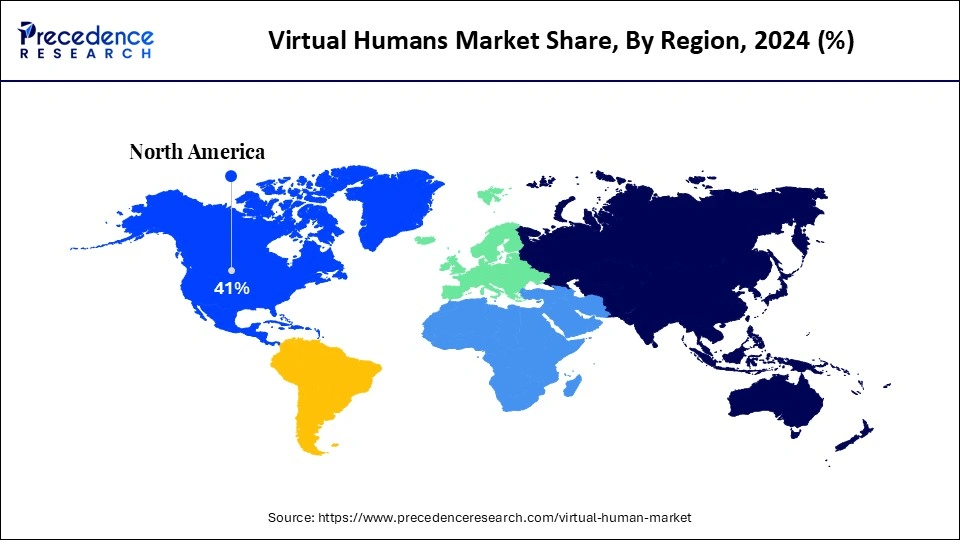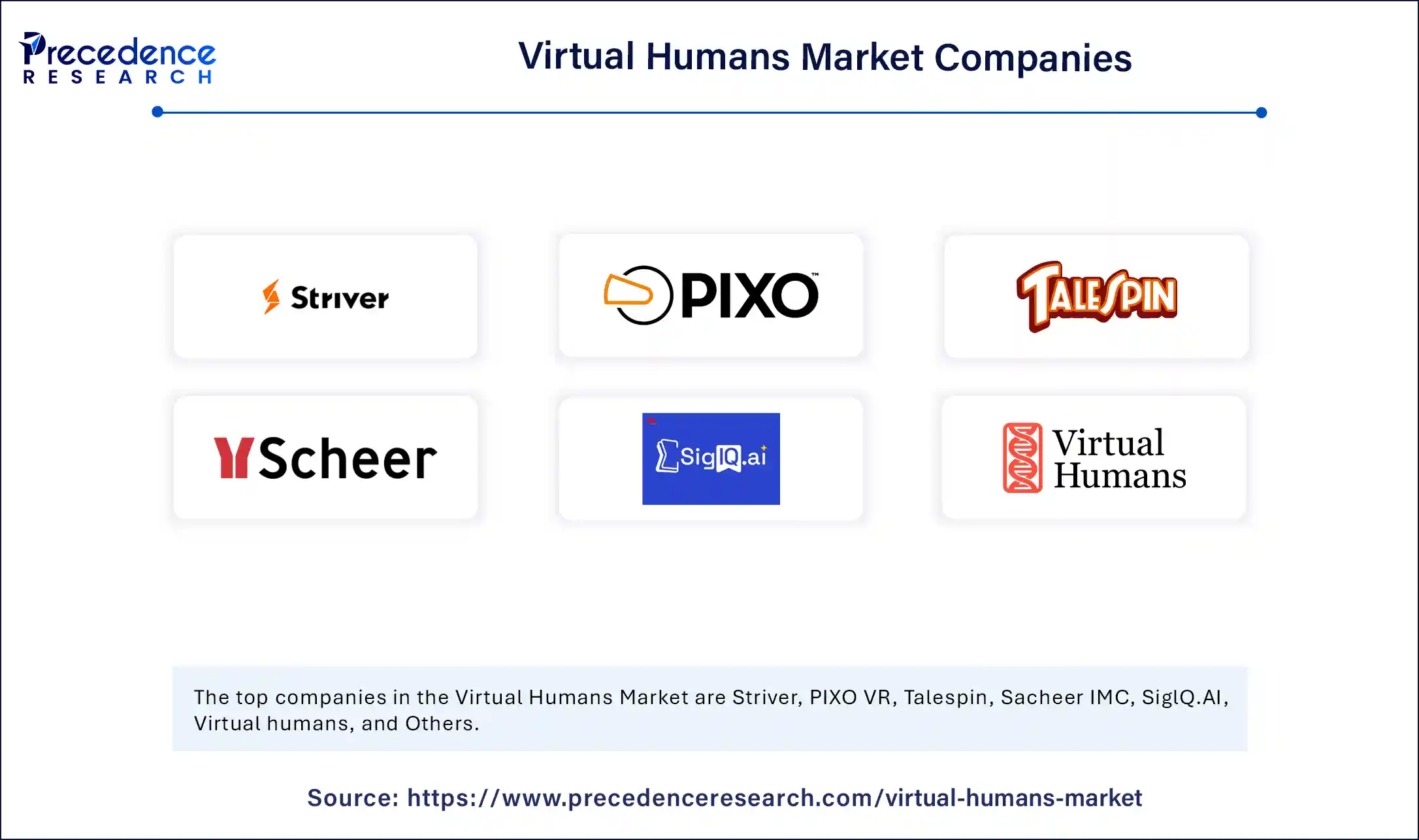List of Contents
Virtual Humans Market Size and Forecast 2025 to 2034
The global virtual humans market size was calculated at USD 4.55 billion in 2024 and is predicted to increase from USD 5.12 billion in 2025 to approximately USD 14.83 billion by 2034, expanding at a CAGR of 12.54% from 2025 to 2034. The market for virtual humans represents a fascinating intersection of artificial intelligence, computer graphics, and human interaction. Virtual humans are highly realistic digital representations designed to stimulate human appearance, behavior, and communication, often powered by advanced AI algorithms.

Virtual Humans Market Key Market Takeaways
- In terms of revenue, the global virtual humans market was valued at USD 4.55 billion in 2024.
- It is projected to reach USD 14.83 billion by 2034.
- The market is expected to grow at a CAGR of 12.54% from 2025 to 2034.
- North America dominated the virtual humans market with the largest market share of 41% in 2024.
- By region, Asia Pacific is anticipated to grow at the fastest CAGR during the forecast period.
- By component type, the software/platform segment held the biggest market share in 2024.
- By component type, the service segment is expected to grow at the fastest CAGR during the forecast period.
- By technology, the NLP & machine learning segment accounted for a considerable share in 2024.
- By technology, the Computer vision & generative AI models segment is projected to experience the highest growth CAGR between 2025 and 2034.
- By type, the interactive virtual humans segment led the market in 2024.
- By type, the non-interactive segment is set to experience the fastest CAGR during the forecast period.
- By application, the customer support & chatbots segment captured the highest market share in 2024.
- By application, the healthcare assistants & virtual influencers are the fastest growing during the forecast period.
- By end-user industry, the media & entertainment segment contributed the maximum market share in 2024.
- By end-user industry, the healthcare & education segment is projected to expand rapidly during the forecast period.
- By deployment mode, the cloud-based segment generated the major market share in 2024.
- By deployment mode, the on-premise segment is projected to expand rapidly during the forecast period.
Beyond the Screen: Navigating the Realms of Virtual Existence and Cybernetic Identity
The global virtual humans market refers to the creation, deployment, and use of AI-driven digital humans designed to simulate human behavior, communication, and interaction in real time. Virtual humans combine technologies such as natural language processing (NLP), computer vision, deep learning, motion capture, and 3D rendering to act as customer service agents, brand ambassadors, virtual influencers, trainers, or companions. These AI-powered avatars are increasingly adopted across industries such as entertainment, retail, healthcare, education, gaming, and enterprise communications. Market growth is fueled by rising demand for hyper-personalized customer engagement, advancements in generative AI, expansion of metaverse applications, and increasing investments in immersive digital experiences.
The virtual human market is witnessing robust growth as enterprises and consumers embrace immersive digital technologies. Increasing adoption across industries such as retail, gaming, healthcare, and education is pushing demand for highly realistic and emotionally responsive avatars. Companies are investing heavily in natural language processing, 3D rendering, and motion capture technologies to improve realism and interactivity. The market is also fueled by the rise of the metaverse, where virtual humans are expected to play a central role as facilitators of engagement and commerce. Startups and tech giants alike are competing to develop scalable platforms that enable businesses to create customized digital personalities. Moreover, the growing focus on enhancing customer experience and reducing service costs is strengthening adoption across multiple sectors.
Top Virtual Humans Market Competitors Across the Globe
| Companies name | Description | Funding received |
| Attensi | Provider of game-based simulation training for businesses. | $32.3M |
| Interplay Learning | Provider of online training solutions based on VR simulation. | $47.1M |
| Simulains | Developer of virtual, augmented, and mixed reality training and productivity tools. | $1.44M |
| Transfr | Online VR-based LMS for enterprises | $90M |
| SpeakX | AI-powered English learning app for students | $7.3M |
(Source: https://tracxn.com)
Why AI is the Key Driver Behind the Growth of the Virtual Humans Market?
Artificial intelligence is a major driver in the virtual humans market is rapidly expanding due to increased adoption of digital technologies across various industries. One significant driver is the demand for realistic avatars that can enhance customer engagement in sectors like retail and gaming. Additionally, advancements in natural language processing and motion capture technologies are improving the realism and interactivity of virtual humans. The rise of the metaverse is also contributing to the market's growth, as virtual humans are expected to facilitate interactions and commerce within these virtual spaces. Furthermore, companies are focused on enhancing customer experience while reducing service costs, leading to wider adoption of virtual human solutions. As businesses recognize the value of personalized digital interactions, the market is poised for continued expansion.
- In August 2025, the idea of virtual humans is nothing new. Lil Miquela, a virtual model created by a Los Angeles-based startup, has 3 million followers on Instagram and kissed Bella Hadid for a Calvin Klein campaign. Imma, the first virtual human in Japan, has partnered with brands like SK-II, Tommy Jeans, and Fenty.(Source: https://jingdaily.com)
U.S. Virtual Humans Market Size and Growth 2025 to 2034
The U.S. virtual humans market size was exhibited at USD 1.31 billion in 2024 and is projected to be worth around USD 4.34 billion by 2034, growing at a CAGR of 12.73% from 2025 to 2034.

Why Does North America Lead the Virtual Humans Market?
North America dominates the virtual humans market, supported by strong investments in AI research, gaming, and immersive technologies. The presence of leading tech companies, advanced infrastructure, and a vibrant entertainment industry creates fertile ground for innovation. Enterprises across healthcare, retail, and education are early adopters of virtual humans, leveraging them to enhance customer engagement and reduce operational costs. Additionally, the region's robust startup ecosystem is continuously experimenting with generative AI and 3D rendering tools. Government and corporate funding for AR/VR projects also strengthens adoption. The cultural openness to immersive technologies further consolidates North America's leadership in this domain.
Research has shown that artificial intelligence is making its way into mental health care using chatbots and virtual assistants, commonly referred to as AI therapists. These tools aim to offer basic emotional support, coping strategies, and guided exercises. Although they cannot replace qualified therapists, they are increasingly becoming an integral component of mental health services globally.(Source: https://www.wionews.com)

Why Is Asia Pacific Emerging As the Fastest-Growing Hub in the Virtual Humans Market?
Asia Pacific is experiencing explosive growth in the virtual humans market, driven by its massive digital population, thriving gaming culture, and rapid technological adoption. Countries like China, Japan, and South Korea are at the forefront of creating virtual idols, influencers, and entertainment personalities with huge fan bases. The region's e-commerce sector is also integrating virtual humans as digital sales representatives to enhance customer interaction. Governments are investing heavily in AI and immersive technology ecosystems, further accelerating adoption. Moreover, the Asia Pacific younger demographic is highly receptive to engaging with digital avatars and metaverse platforms, propelling demand. This combination of cultural enthusiasm and technological momentum positions Asia Pacific as the fastest-growing hub in the global market.
Market Key Trends
- Rise in adoption of virtual humans in the metaverse and immersive digital platforms.
- Increasing role of virtual humans in healthcare for counseling and therapy.
- Integration of virtual humans into customer service and e-commerce.
- Growth in demand for hyper-realistic avatars using motion capture and generative AI.
- Expansion of virtual influencers in marketing and entertainment.
- Rising investment in mixed reality ecosystems and humanized AI companies.
Market Scope
| Report Coverage | Details |
| Market Size by 2034 | USD 14.83 Billion |
| Market Size in 2025 | USD 5.12 Billion |
| Market Size in 2024 | USD 4.55 Billion |
| Market Growth Rate from 2025 to 2034 | CAGR of 12.54% |
| Dominating Region | North America |
| Fastest Growing Region | Asia Pacific |
| Base Year | 2024 |
| Forecast Period | 2025 to 2034 |
| Segments Covered | Component, Technology, Type, Application, End-Use Industry, Deployment Mode, and Region |
| Regions Covered | North America, Europe, Asia-Pacific, Latin America, and Middle East & Africa |
Market Dynamics
Drivers
Unleashing the Future: Key Drivers of the Virtual Humans Market
The virtual humans market is propelled by an increasing demand for engaging and realistic avatars across various industries. In retail and gaming, these digital personalities enhance customer experiences, making interactions feel more personal and dynamic. Technological advancements in natural language processing and motion capture are revolutionizing the way virtual humans connect, offering unprecedented realism and interactivity. The burgeoning metaverse is another pivotal factor, as virtual humans are set to become the linchpins of social interaction and commerce within these immersive environments. Businesses are also recognizing the potential of virtual human solutions to reduce service costs while enhancing customer satisfaction. As industries strive for hyper-personalized engagement, the virtual humans market stands at the forefront of innovation and opportunity.
In 1964, Boeing created the first digital representation of a human using an image of an actual person. Since that time, technology for virtual humans has gradually transitioned from the realm of laboratory research to the commercial market, gaining popularity in the digital era. From a technical perspective, virtual humans are virtual entities that have been realized in recent years due to the ongoing advancements in information technologies, including computer graphics, motion capture, machine learning, high-precision rendering, and speech synthesis. Regarding the construction of digital human images, earlier digital human models primarily relied on modeling software to manually create models, which proved to be an inefficient and expensive approach.(Source: https://ieeexplore.ieee.org)
Restraints
Challenge of Ethics and Trust
Despite rapid growth, the virtual humans market faces challenges related to ethics, trust, and authenticity. As virtual humans become more lifelike, concerns around identity manipulation, misinformation, and deepfakes misuse are intensifying. Users may struggle to differentiate between real and virtual interactions, raising questions of transparency and accountability. Additionally, creating hyper-realistic avatars requires significant investment in AI and graphics technology, which can limit accessibility for smaller players. Privacy issues also arise when virtual humans process personal or sensitive data in customer interactions. Unless these challenges are addressed through clear regulation, responsible innovation, and transparent practices, the adoption of virtual humans may encounter resistance in certain sectors.
Opportunity
Untapped Frontier of the Metaverse
The rise of the metaverse presents unprecedented opportunities for the virtual humans market. In these shared digital worlds, virtual humans serve as guides, educators, entertainers, and even business representatives, enabling brands and individuals to extend their presence in immersive environments. Retail companies are exploring virtual sales associates, while educational institutions are adopting virtual tutors to provide personalized learning. Healthcare providers are also investigating virtual doctors and therapists to bridge accessibility gaps. Moreover, virtual humans are gaining traction as influencers, commanding significant followership and brand partnerships. As metaverse ecosystems mature, the demand for customizable, lifelike virtual humans will skyrocket, opening avenues for innovation and cross-industry collaboration.
- In September 2025, a study revealed that the metaverse has emerged as one of the most hyped concepts of recent years. It is commonly characterized as an expansive virtual environment that melds the digital and physical realms, allowing users to live, work, play, and socialize, as well as engage in economic activities. The landscape of digital commerce has rapidly evolved, encompassing everything from experiential platforms to virtual real estate. Some research indicates that in the near future, the metaverse could dominate the blockchain space, potentially leading to a diminished role for cryptocurrencies within this integrated ecosystem.(Source: https://www.outlookindia.com)
Component Insights
Why Is Software/Platform Leading the Virtual Humans Market?
The software/platforms segment is leading the virtual humans sector; it is considered the backbone of the virtual human market, enabling the development, customization, and customization of highly interactive avatars. These platforms integrate advanced AI engines, natural language processing, and rendering capabilities to stimulate realistic interactions. Their scalability and ability to support multiple use cases, from entertainment to enterprise customer service, make them the most widely adopted. Companies prefer robust platforms that allow continuous updates, integration with AR/VR ecosystems, and seamless cross-device performance. The dominance of software platforms also stems from their critical role in shaping user experience and ensuring realism.
The service is the fastest-growing in the virtual human space, as it covers consulting, integration, and managed services, and is experiencing rapid growth as organizations seek tailored virtual human solutions. Businesses often lack the in-house expertise to design and optimize virtual avatars, driving demand for specialized service providers. With rising adoption across healthcare, education, and e-commerce, the need for ongoing customization, performance monitoring, and training has expanded significantly. Moreover, service providers offer end-to-end support in deploying cloud-based or hybrid models. This strong reliance on professional services makes this segment the fastest-growing.
Technology Insights
Why NLP & Machine Learning Are Leading the Virtual Humans Market?
Natural language processing (NLP) and machine learning dominate the technology segment in the market for virtual humans due to their pivotal role in enabling natural, human-like conversations. NLP allows virtual humans to interpret tone, intent, and context, delivering responses that feel intuitive and empathetic. Machine learning algorithms ensure that these avatars evolve continuously through interaction, improving accuracy and personalization over time. From customer service chatbots to virtual tutors, NLP is the foundation of realistic and engaging communication. The dominance of these technologies lies in their scalability and adaptability across multiple industries. Their continued evolution cements them as the cornerstone of virtual human intelligence.
The non-interactive is the fastest growing in the virtual human market, following their contribution towards creating hyper-realistic avatars with expressive facial movements, gestures, and body language. The fusion of generative AI with vision capabilities is expected to transform virtual humans into more immersive and emotionally engaging entities, expanding their applications. Advancements in generative AI and vision technologies are enabling hyper-realistic avatars, gestures, and emotional responsiveness to stimuli like humans is making them the backbone of the virtual humans.
A groundbreaking study from cutting-edge tech firms has revealed that a whopping 55% of YouTubers are now leveraging AI avatars to create a truly lifelike experience! These digital personas not only enhance the realism of their content but also engage viewers with an incredible human-like presence. Even leading video editing companies are jumping on board, offering innovative tools that transform plain text into captivating animations that feel like real interactions with an audience. The future of content creation is here, and it's more thrilling than ever!
Type Insights
Why Are Interactive Virtual Humans Leading the Market?
The interactive virtual humans segment is dominating the market, revolutionizing how businesses engage with customers. Their ability to provide personalized experiences enhances customer satisfaction and loyalty, ultimately driving sales and brand recognition. As advancements in AI and motion capture technology continue, these digital avatars become increasingly lifelike and emotionally responsive, capturing the attention of users across industries. In retail, they serve as virtual assistants, guiding consumers through purchasing decisions with tailored recommendations. Meanwhile, in healthcare, interactive virtual humans facilitate patient counseling and support, addressing needs with empathy and understanding. As the metaverse expands, the influence of these avatars will only grow, making them essential components of immersive digital experiences.
The non-interactive segment is the fastest-growing in the virtual humans market, as it caters to various consumer needs without requiring user engagement. One of the fastest-growing segments includes digital signage, which delivers real-time information and advertisements in commercial spaces. Additionally, non-interactive content, such as streaming services and video-on-demand platforms, has surged in popularity, providing users with endless entertainment options. Similarly, augmented reality experiences that do not require user interaction are increasingly being adopted in marketing campaigns to attract attention. This trend is also evident in the development of immersive displays in public spaces, enhancing environments with captivating visuals. As consumers seek effortless ways to receive information and entertainment, non-interactive technologies continue to expand their presence across multiple sectors.
Application Insights
Why Do Customer Support and Chatbots Make Up the Largest Market Share?
The customer support and chatbots make up the largest share of the market, represent the dominating application segment for virtual humans. Companies leverage them to handle repetitive queries, reduce operational costs, and improve customer satisfaction. The adoption of AI-driven chatbots has surged as enterprises recognize their value in providing 24/7 assistance and personalized engagement.
The healthcare assistants & virtual influencers are the fastest-growing in the industry. In healthcare, virtual humans are being used for patient monitoring, digital therapy, and teleconsultations, while in marketing, virtual influencers are reshaping brand promotions. These emerging applications highlight the growing trust in virtual humans beyond traditional customer service roles.
End-Use Industry Insights
Why Are Media and Entertainment Dominating the Market for Virtual Humans?
The media & entertainment are dominating the virtual humans market as they are widely adopted in gaming, filmmaking, animation, and virtual concerts, where lifelike avatars enhance immersive experiences. The industry benefits from virtual humans that can perform, interact, and even replace human actors in certain roles.
Healthcare & Education are the fastest-growing sectors in the industry. In healthcare, virtual nurses and assistants improve patient interaction and reduce clinical workload, while in education, virtual tutors make learning more engaging and accessible. This dual adoption across creative and professional sectors reflects the versatility of virtual humans.
Deployment Mode Insights
Why Cloud Based Is Cloud-Based Dominating the Market?
Cloud-based deployment dominates the virtual human market, as it allows organizations to scale quickly and reduce infrastructure costs. Cloud platforms provide flexibility, enabling businesses to deploy virtual humans across multiple geographies with minimal effort. They also support frequent updates and seamless integration with AI tools.
However, on-premise deployment is projected to grow at the fastest rate. Industries with stringent data security and privacy needs, such as healthcare and defense, are increasingly adopting on-premise models. This growth reflects a balance between the convenience of cloud and the control offered by local infrastructure.
Quick Picks
Father of Virtual Reality
Morton L. Heilig, often recognized as the progenitor of virtual reality, made significant contributions to the concept of immersive experiences that we now associate with the medium. In 1956, he played a pivotal role in bringing the term virtual reality into mainstream discussion, highlighting his innovative vision as an American inventor, philosopher, and cinematographer. Heilig was ahead of his time, consistently exploring uncharted territory in technology and its implications for human experience.(Source: https://3dinsider.com)
How Robotic Skin is Made
Current research in soft robotics is pushing the boundaries of innovation by designing sensors that mimic the softness and remarkable tactile sensitivity of human skin, making human–robot interaction far safer and more natural. Human skin, one of our most vital organs, is a masterful interface that perceives temperature, pressure, and texture, allowing us to navigate and respond to our surroundings with precision.(Source: https://www.mdpi.com)
Hieroglyphics as Proto-Visualization
The roots of proto-visualization can be traced back to ancient Egypt, where hieroglyphics served as symbolic tools of communication, carved into stone to convey meaning from person to person. Similarly, early humans relied on inscriptions and drawings etched onto cave walls and stones to share ideas, stories, and experiences. In the modern era, this legacy of symbolic communication finds a parallel in virtual humans, which are trained through machine learning models to replicate human interaction. Just as hieroglyphs once acted as a bridge between minds, today's digital avatars act as a bridge between humans and machines. While the concept of creating lifelike representations of ourselves has existed for thousands of years, it truly began to gain prominence in the late 19th century, eventually evolving into the sophisticated virtual human technologies we see today.(Source: https://www.mdpi.com)
Virtual Humans Market Comapnies

Recent Developments
- In July 2025, archaeologists uncovered a vast 5000-year-old fortress concealed within dense forests in Neamt county, Romania. Belonging to the transitional era between the Neolithic and Bronze Age, the site reveals a highly organized settlement that challenges earlier assumptions about the region's early societies. The remarkable finds offer fresh insight into the complexity and advancement of ancient civilizations that lay hidden for centuries beneath layers of vegetation.(Source: https://dailygalaxy.com)
Segments Covered in the Report
By Component
- Software/Platform
- Services (Customization, Training, Managed Services)
By Technology
- Natural Language Processing (NLP)
- Computer Vision
- Machine Learning & Deep Learning
- 3D Graphics & Rendering
- Motion Capture & Animation
- Speech Synthesis & Voice Recognition
- Computer Vision & Generative AI Models
By Type
- Interactive Virtual Humans (real-time conversational AI avatars)
- Non-Interactive Virtual Humans (pre-programmed, scripted)
By Application
- Customer Support & Chatbots
- Virtual Influencers & Brand Ambassadors
- Healthcare Assistants (mental health, patient care)
- Education & Training (virtual tutors, skill training)
- Entertainment & Gaming (characters, streamers)
- Enterprise Collaboration & HR (virtual recruiters, trainers)
- Others (companionship, lifestyle assistants)
- Healthcare Assistants & Virtual Influencers
By End-Use Industry
- Media & Entertainment
- Retail & E-Commerce
- Healthcare & Life Sciences
- Education & EdTech
- IT & Telecom
- BFSI
- Gaming
- Others
- Healthcare & Education
By Deployment Mode
- Cloud-Based
- On-Premises
By Region
- North America
- Europe
- Asia-Pacific
- Latin America
- Middle East & Africa
For inquiries regarding discounts, bulk purchases, or customization requests, please contact us at sales@precedenceresearch.com
Frequently Asked Questions
Ask For Sample
No cookie-cutter, only authentic analysis – take the 1st step to become a Precedence Research client